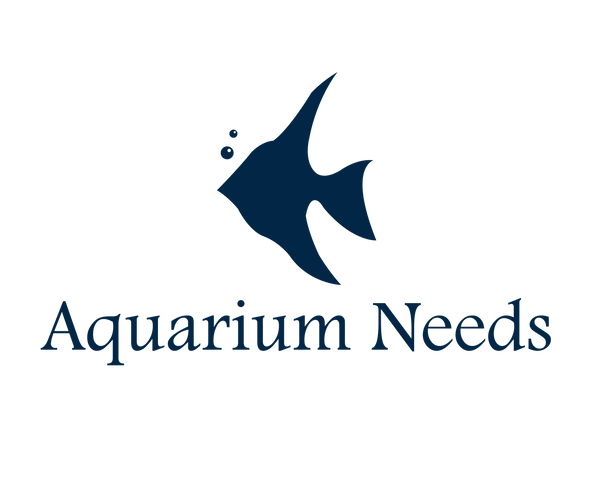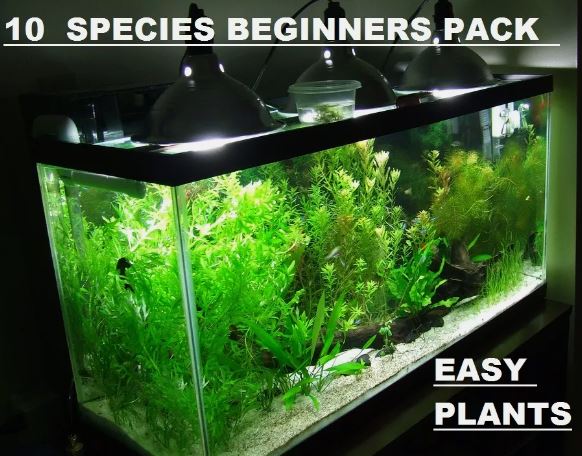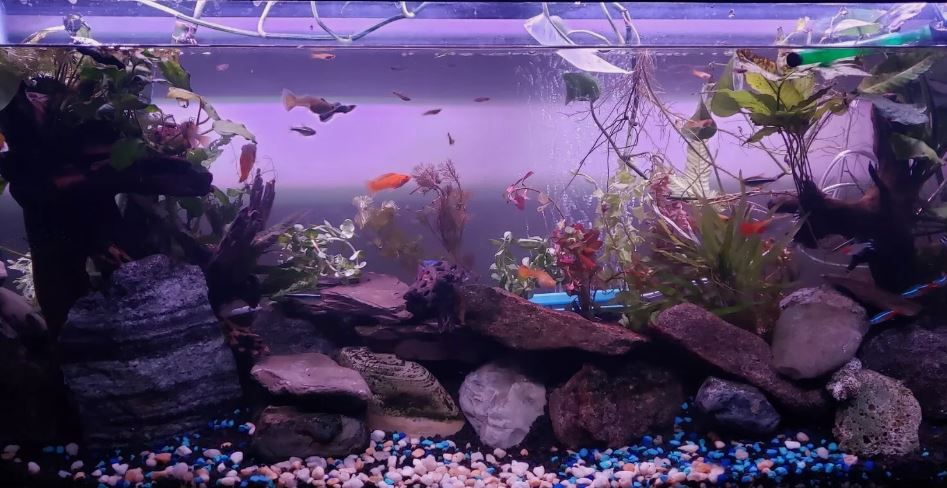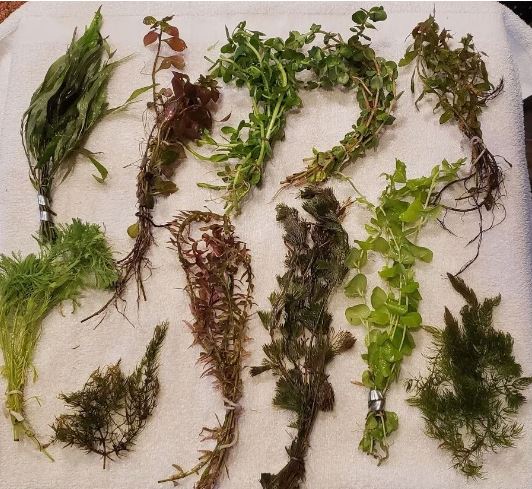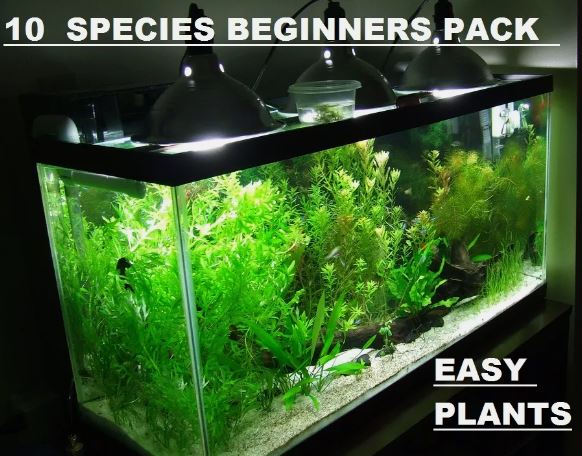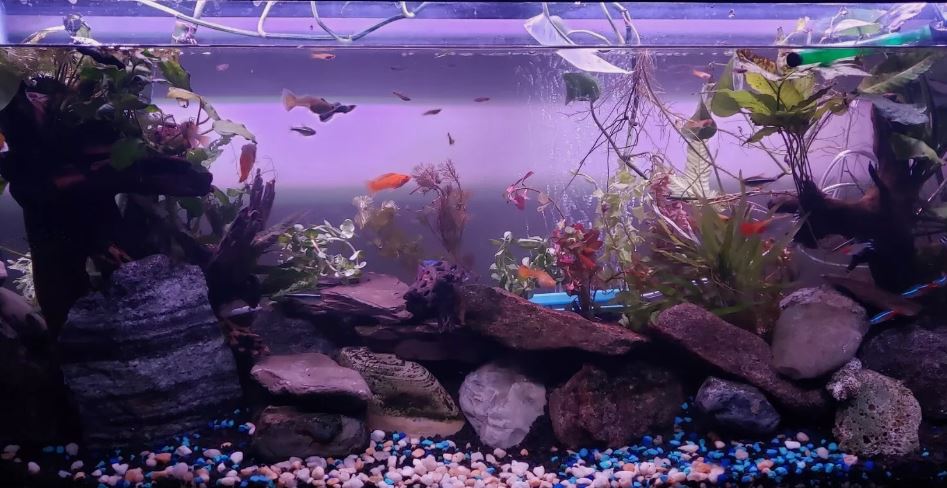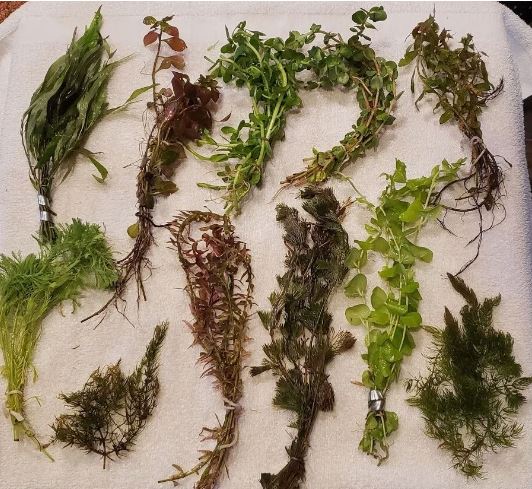Description
Description
Cabomba (Cabomba caroliniana)

The Cabomba, also known as the Carolina Fanwort, has feathery green leaves, which are divided into narrow segments. It is a densely growing plant that makes for a wonderfull, natural looking background in a planted aquarium. Cabomba does best when grown in nuetral water under moderate lighting. Provide at least 2 watts per gallon of full spectrum (5000-7000K) lighting. Water temperature between 72°-82°F, an alkalinity of 3-8 dKH and a pH of 6.5-7.5 is ideal for proper growth. These plants do not tolerate frequent trimming and transplanting. Leaves dropping from the plant are usually a sign of poor water Propagate the Cabomba by trimming branches from the main plant, and relocating them in another part of the aquarium. It should be placed in the back or sides of your aquarium in groups for the best appearance.
Wisteria (Hygrophila difformis)

The Wisteria, also known as the Water Wisteria, is an undemanding, extremely attractive aquarium plant. The lace-like leaves vary in appearance under different conditions. If the water is colder, they will be small, and lobed in appearance, instead of pinnate. If insufficient light is provided, they will only be slightly pinnate. The Wisteria is an excellent plant for the new aquarist or for the newly set-up aquarium. It requires a nutrient-rich substrate, with iron-rich fertilizer added regularly. Provide a moderate amount of lighting of at least 2 to 3 watts per gallon of full spectrum (5000-7000K) light. For Wisteria to thrive, the water should be kept between 74°-82°F, with an alkalinity of 3 to 8 dKH and a pH of 6.5-7.5. To propagate, plant cuttings that have been removed from the healthy mature plant. Simply remove any leaves from the bottom 1" to 2" of the stem, and new root growth will form from the last node on the stem.
Alternanthera reineckii

Alternanthera reineckii 'rosaefolia' can be grown with lower light levels and without CO2 supplementation but will not reach its true growth potential. Moderate to high lighting (2-4 watts per gallon) and CO2 injection is more ideal but not compleltly nessesary. This species can grow well in both hard and soft water, although soft, slightly acidic water is best. This plant, unlike most other red plants, prefers rich conditions with high nitrates (10 ppm or more) and high phosphate (0.5 ppm or more). If grown under lean conditions under very high light, substrate fertilization placed at the roots will greatly enhance growth and overall health. Initially, plant each stem separately. This species is easily propagated by nipping off the terminal bud and planting it in the bottom. This also makes the mother plant more bushy, because more side shoots are formed. The purple color underneath Alternanthera reineckii 'roseafolia' leaves provides an effective contrast to the many green plants in an aquarium particularly when planted in groups. Three to five strong specimens can be used for the background area to help accent the shades of green aquarium plants., This is the most popular red plant used in Dutch style aquariums.
Hornwort (Ceratophyllum submersum)

Hornwort's sturdy, bristly foliage can help to eliminate algae and clarify water. The plant's tips get shorter and thicker in the fall, eventually falling off and turning to buds. Hornwort is typically found floating in water or loosely anchored in mud, and it can be rooted in an aquarium or left floating. Its dark green leaves can reach lengths of ½ inches, and its stems can grow to be as long as 2 feet.
AMBULIA
(Limnophila indica)

Limnophila indica is a good and undemanding plant which is a good alternative to Cabomba, which demands a lot of light. Most beautiful when planted in groups. In good growing conditions it sends out runners and spreads across the bottom.
Lloydiella Golden
(Lysimachia nummularia var. 'Aurea')

This is a cultivar of the popular aquarium plant known as Creeping Jenny. It has a sightly golden color. It is needs fairly bright light because of the light colr of it's leaves and it is pretty much undemanding. It is slow growing and forms a nice bush. It also holds on to its older leaves and is not too susceptible to algae.
Potamogeton GAYI

P. gayi is easy to grow, since it makes few demands on the hobbyist. This species is not too fussy about fertilization, and a medium light intensity is sufficient for good growth. CO2 injection is not required, although it is beneficial. P. gayi is tolerant of a wide range of pH values and will grow well in medium-hard water. This species has a long adjustment period when planted, and care should be exercised in placement as to avoid the need for replanting. The narrow, 5-9mm wide leaves range from an olive green to a reddish brown and grow to be 5-10cm long. The undemanding and gracefully slender P. gayi should be planted in groups in the midground or background of medium- to large-sized aquariums. If lighting is intense and it is trimmed short, P. gayi can also be used as a foreground plant in large aquariums
Rotala Nanjenshan (Rotala nanjenshan)

Rotala Nanjenshan is an ideal mid-ground plant that will add color to the freshwater planted aquarium. Because of the small leaf size, it will grow rather densely, and may need to be thinned out in time. Reproduction within this species is by cuttings. Simply cut the plant at the height that you desire, but leave room for growth, then strip the leaves about an inch off of the stem, and plant into the gravel. In time, roots will form at the last node and will aid in keeping the plant in place. This plant will benefit from regular additions of , , and .
ROTALA WALLICHII

Rotala wallichii is an elegant stem plant found in soft, acidic bodies of water in southeast Asia, where it is much more often found growing submerged and in deeper water than related species. It produces flower spikes adorned with bright, . Although not the easiest of aquatic plants to grow, R. wallichii is one of the most popular, commonly available red stem plants in the hobby. This Rotala forms luxurious, fluffy, pink groupings which grow to the water's surface. This plant produces its most colorful, vibrant growth along the water's surface, where it also develops the greatest number of side shoots. When it gets too tall, R. wallichii can be pruned by cutting off the tops and leaving behind the rooted portions or uprooting the rooted portions and replanting the tops. Propagation can be performed by simply snipping off stems that are too tall and replanting them in the substrate. R. wallichii is often used in both Nature style and Dutch style layouts as a colorful, reddish accent located in the midground or background. For best effect, it should be planted three to five stems at a time with a pair of to form large, dense groupings.
TEMPLE NARROW LEAF

The Hygrophila, Temple Narrow Leaf with its thick stems and broad bright green leaves that can reach a length of 5" underwater, the Hygrophila corymbosa plant makes a unique addition to a freshwater planted aquarium. The Hygrophila, Temple Narrow Leaf plant will grow to a maximum size of 24", and should be pruned regularly to keep it from shading its neighbors. It makes an ideal background plant that will help in hiding the aquarium's equipment. This plant will not begin to branch until the top has been cut. Reproduction within this species is by cuttings. Simply cut the plant at the height that you desire, but leave room for growth, then strip the leaves off of about an inch of the stem, and plant into the gravel. In time, roots will form at the last node and will aid in keeping the plant in place. The Hygrophila plant benefits from regular additions of CO2, iron rich fertilizers, and trace elements.
Shipping Information
Shipping Information
For the fastest service send us a message here .
Domestic shipping only! Sorry, we cannot ship to anyone in Hawaii & Washington State.
We ship on Monday, Tuesday, and Wednesday via USPS Priority Mail. Once we get your order, we will ship it within 1 to 5 business days. For the safety of the animals, we do not ship aquatic life on Thursday and Friday. We do not want live aquatic animals sitting in USPS warehouse over the weekend. Thank you for your understanding.
Any orders placed before 12:00 PM on Tuesday will be shipped out that same week. orders placed after 12:00 PM on Tuesday will now be processed the following week
Male/Female: Will be picked at random (no custom orders)
Note: color may be slightly off from photo.
We placed a penny at the corner of the tank so you can have an idea of the size of the fish.
Guaranteed to arrive alive you have one hour of delivery to report any death. You must take a picture while the fish is dead in the bag before it’s opened.
Fish’s color might be off first 3 days due to shipping and stressed fish.
we do not refund shipping costs
